Cracking Down on Coliforms: How KRAKEN™ Protects Water Quality Across Manufacturing and Industrial Facilities
Across today’s manufacturing landscape—whether in food and beverage, consumer goods, cosmetics, industrial processing, agriculture, or chemical production—water purity remains one of the most critical and challenging aspects of operations. Even a small microbial intrusion can disrupt production, compromise product quality, trigger costly downtime, and put consumer safety at risk.
Among all microbial threats, coliform bacteria stand out as one of the most important early-warning indicators of contamination.
But detecting them fast enough to act? That’s where many facilities fall behind.
This blogpost will break down what coliform bacteria are, why they matter across manufacturing environments, and how KRAKEN™, Kraken Sense’s automated, real-time microbial detection platform, provides the speed and precision needed to prevent contamination before it spreads.
What Are Coliform Bacteria—and Why Do They Matter in Manufacturing?
Coliform bacteria are a group of Gram-negative, non-spore-forming rods found naturally in soil, water, and the intestinal tracts of warm-blooded animals. They include well-known genera such as:
Escherichia
Enterobacter
Citrobacter
Klebsiella
While many coliforms are not harmful on their own, they serve as critical indicator organisms. Their presence signals:
poor sanitation
equipment cleaning failures
intrusion of contaminated raw water
biofilm formation in piping or tanks
fecal contamination
broader environmental contamination
Most importantly, they warn that more dangerous pathogens (e.g., Salmonella, Pseudomonas, E. coli O157:H7, viruses, protozoa) may also be present.
For industries such as food & beverage, bottling, cosmetics, brewing, dairy, agriculture, and advanced manufacturing, coliforms should never be detected in critical process water, ingredient water, cleaning systems, or final-rinse lines.
When they show up, they tell a story—and it’s never a good one.
How Coliform Contamination Forms in Manufacturing Water Systems
Manufacturing facilities often rely on large, interconnected water systems—piping networks, holding tanks, filtration systems, heat exchangers, CIP loops, and distribution lines. While designed to support high-quality production, these systems are vulnerable to microbial contamination.
Coliform presence often emerges from:
1. Biofilm Formation
Stagnant areas, poorly sanitized pipes, or aging equipment allow biofilms to develop. Once established, biofilms become microbial reservoirs that continuously release bacteria—including coliforms—into the water stream.
2. Mechanical or Equipment Failures
Worn gaskets, faulty valves, poor heat cycles, and incomplete cleaning cycles create ideal entry points for environmental bacteria.
3. Intrusion of Contaminated Feed Water
A brief raw water upset, pressure fluctuation, or backflow incident can introduce coliforms into the system.
4. Slow or Infrequent Testing
Traditional culture-based methods take 24–48 hours, leaving facilities blind to real-time problems while contaminated water continues to circulate.
E. coli Indicates:
fecal contamination
critical sanitation failure
immediate threat to consumer safety (especially in food and beverage)
This is why many industries enforce zero-tolerance policies for coliforms and E. coli in their water systems and finished goods.
How Coliform Contamination Impacts Human Health
Even though many coliforms are not inherently dangerous, they act as gateways for more severe contamination. Some coliform species can directly cause disease:
Citrobacter – UTIs, bacteremia, neonatal meningitis
Enterobacter – pneumonia, post-operative infections, bloodstream infections
Klebsiella pneumoniae – respiratory infections, bloodstream infections, antibiotic-resistant outbreaks
E. coli pathotypes – severe gastrointestinal illness, hemorrhagic diarrhea, kidney failure (HUS)
A single coliform detection, especially in food or consumer-facing industries, can signal a risk that harmful pathogens are also present.
The Problem With Traditional Detection Methods
Many manufacturing plants still rely on slow, labor-intensive methods such as:
membrane filtration
multiple-tube fermentation
plate culture methods
This delay increases:
product quality failures
contamination spread
downtime
investigation and cleaning costs
regulatory or food safety exposure
KRAKEN™: Real-Time Defense Against Coliform Contamination
KRAKEN™ brings water safety into a new era—shifting facilities from reactive to proactive microbial control.
Continuous, Real-Time Coliform Detection
KRAKEN™ samples water repeatedly throughout the day, catching contamination at the earliest possible stage—not hours or days later.
Fully Automated Sample Processing
No manual handling, enrichment, or plate work. The system performs extraction, detection, and reporting automatically.
Detects Coliforms and E. coli in Under 120 Minutes
A major improvement over traditional 24–48 hour methods—giving teams actionable data on the same shift.
Multi-Target Microbial Detection
Coliforms rarely appear alone. KRAKEN™ can detect multiple organisms simultaneously, including:
E. coli
Pseudomonas aeruginosa
Salmonella
Staphylococcus aureus
and additional pathogens relevant to food, beverage, cosmetics, and industrial water.
Cloud-Connected Insights
A real-time dashboard shows current results, trends, and automated alerts—enabling quick decision-making and continuous oversight.
Seamless Integration Into Existing Systems
KRAKEN™ installs easily into existing water lines, CIP systems, ingredient water loops, and process points—no infrastructure overhaul required.
Why This Matters for Manufacturing Facilities
With KRAKEN™, plants gain:
Early detection of biofilms
Prevention of product contamination
Fewer deviations and investigations
Reduced downtime
Improved process reliability and safety
Significant time and cost savings
Higher-quality outputs and greater consumer trust
Coliforms aren’t just microorganisms—they’re red flags. Detecting them in real time gives facilities the chance to stop contamination before it becomes a recall-level event.

